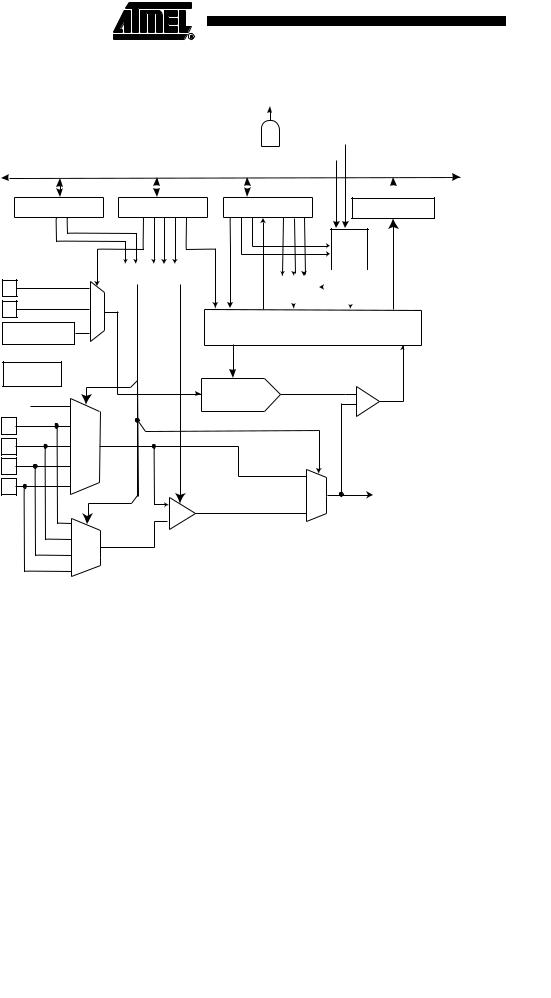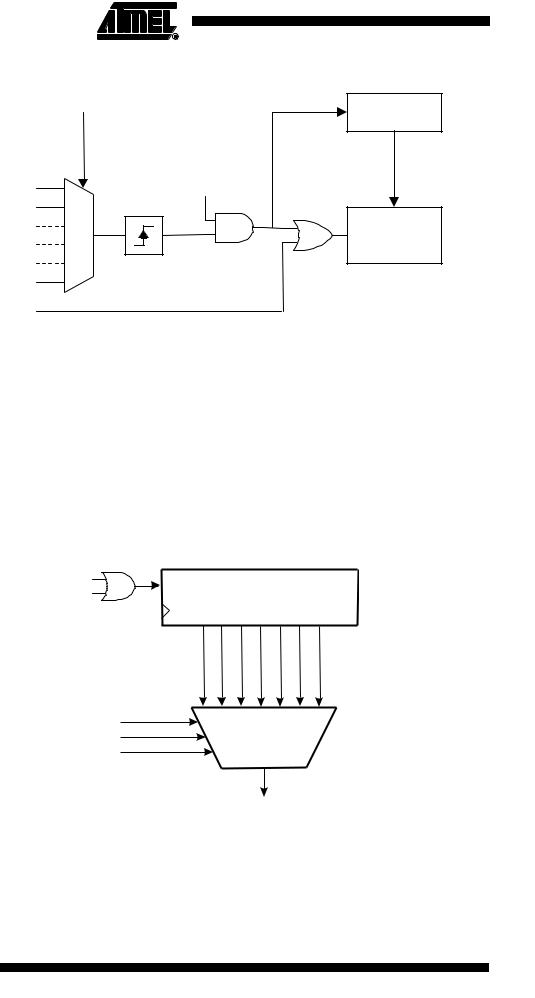
- •Features
- •1. Pin Configurations
- •1.1 Disclaimer
- •2. Overview
- •2.1 Block Diagram
- •2.2 Pin Descriptions
- •2.2.3 Port B (PB5..PB0)
- •2.2.4 RESET
- •3. About Code Examples
- •4. AVR CPU Core
- •4.1 Introduction
- •4.2 Architectural Overview
- •4.4 Status Register
- •4.5 General Purpose Register File
- •4.6 Stack Pointer
- •4.7 Instruction Execution Timing
- •4.8 Reset and Interrupt Handling
- •4.8.1 Interrupt Response Time
- •5. AVR ATtiny25/45/85 Memories
- •5.2 SRAM Data Memory
- •5.2.1 Data Memory Access Times
- •5.3 EEPROM Data Memory
- •5.3.1 EEPROM Read/Write Access
- •5.3.5 Atomic Byte Programming
- •5.3.6 Split Byte Programming
- •5.3.7 Erase
- •5.3.8 Write
- •5.3.9 Preventing EEPROM Corruption
- •5.4 I/O Memory
- •6. System Clock and Clock Options
- •6.1 Clock Systems and their Distribution
- •6.2 Clock Sources
- •6.3 Default Clock Source
- •6.4 Crystal Oscillator
- •6.6 Calibrated Internal RC Oscillator
- •6.7 External Clock
- •6.8 128 kHz Internal Oscillator
- •6.9 Clock Output Buffer
- •6.10 System Clock Prescaler
- •6.10.2 Switching Time
- •7. Power Management and Sleep Modes
- •7.1 Idle Mode
- •7.2 ADC Noise Reduction Mode
- •7.4 Power Reduction Register
- •7.5 Minimizing Power Consumption
- •7.5.1 Analog to Digital Converter
- •7.5.2 Analog Comparator
- •7.5.4 Internal Voltage Reference
- •7.5.5 Watchdog Timer
- •7.5.6 Port Pins
- •8. System Control and Reset
- •8.0.1 Resetting the AVR
- •8.0.2 Reset Sources
- •8.0.3 Power-on Reset
- •8.0.4 External Reset
- •8.0.6 Watchdog Reset
- •8.1 Internal Voltage Reference
- •8.2 Watchdog Timer
- •8.3 Timed Sequences for Changing the Configuration of the Watchdog Timer
- •8.3.1 Safety Level 1
- •8.3.2 Safety Level 2
- •9. Interrupts
- •9.1 Interrupt Vectors in ATtiny25/45/85
- •10. External Interrupts
- •11. I/O Ports
- •11.1 Introduction
- •11.2 Ports as General Digital I/O
- •11.2.1 Configuring the Pin
- •11.2.2 Toggling the Pin
- •11.2.3 Switching Between Input and Output
- •11.2.4 Reading the Pin Value
- •11.2.5 Digital Input Enable and Sleep Modes
- •11.2.6 Unconnected Pins
- •11.3 Alternate Port Functions
- •11.3.2 Alternate Functions of Port B
- •12. 8-bit Timer/Counter0 with PWM
- •12.1 Overview
- •12.1.1 Registers
- •12.1.2 Definitions
- •12.2 Timer/Counter Clock Sources
- •12.3 Counter Unit
- •12.4 Output Compare Unit
- •12.4.1 Force Output Compare
- •12.4.2 Compare Match Blocking by TCNT0 Write
- •12.4.3 Using the Output Compare Unit
- •12.5 Compare Match Output Unit
- •12.5.1 Compare Output Mode and Waveform Generation
- •12.6 Modes of Operation
- •12.6.1 Normal Mode
- •12.6.2 Clear Timer on Compare Match (CTC) Mode
- •12.6.3 Fast PWM Mode
- •12.6.4 Phase Correct PWM Mode
- •12.7 Timer/Counter Timing Diagrams
- •13. Timer/Counter Prescaler
- •13.0.1 Prescaler Reset
- •13.0.2 External Clock Source
- •14. 8-bit Timer/Counter1
- •14.1 Timer/Counter1
- •14.1.1 Timer/Counter1 Control Register - TCCR1
- •14.1.2 General Timer/Counter1 Control Register - GTCCR
- •14.1.3 Timer/Counter1 - TCNT1
- •14.1.4 Timer/Counter1 Output Compare RegisterA - OCR1A
- •14.1.5 Timer/Counter1 Output Compare RegisterB - OCR1B
- •14.1.6 Timer/Counter1 Output Compare RegisterC - OCR1C
- •14.1.7 Timer/Counter Interrupt Mask Register - TIMSK
- •14.1.8 Timer/Counter Interrupt Flag Register - TIFR
- •14.1.9 PLL Control and Status Register - PLLCSR
- •14.1.10 Timer/Counter1 Initialization for Asynchronous Mode
- •14.1.11 Timer/Counter1 in PWM Mode
- •15. 8-bit Timer/Counter1 in ATtiny15 Mode
- •15.1 Timer/Counter1 Prescaler
- •15.2 Timer/Counter1
- •15.2.1 Timer/Counter1 Control Register - TCCR1
- •15.2.2 General Timer/Counter1 Control Register - GTCCR
- •15.2.3 Timer/Counter1 - TCNT1
- •15.2.4 Timer/Counter1 Output Compare RegisterA - OCR1A
- •15.2.5 Timer/Counter1 Output Compare Register C - OCR1C
- •15.2.6 Timer/Counter1 Interrupt Mask Register - TIMSK
- •15.2.7 Timer/Counter Interrupt Flag Register - TIFR
- •15.2.8 PLL Control and Status Register - PLLCSR
- •15.2.9 Timer/Counter1 in PWM Mode
- •16. Dead Time Generator
- •16.0.1 Timer/Counter1 Dead Time Prescaler register 1 - DTPS1
- •16.0.2 Timer/Counter1 Dead Time A - DT1A
- •16.0.3 Timer/Counter1 Dead Time B - DT1B
- •17.1 Overview
- •17.2 Functional Descriptions
- •17.2.2 SPI Master Operation Example
- •17.2.3 SPI Slave Operation Example
- •17.2.5 Start Condition Detector
- •17.3 Alternative USI Usage
- •17.3.4 Edge Triggered External Interrupt
- •17.3.5 Software Interrupt
- •17.4 USI Register Descriptions
- •18. Analog Comparator
- •18.1 Analog Comparator Multiplexed Input
- •19. Analog to Digital Converter
- •19.1 Features
- •19.2 Operation
- •19.3 Starting a Conversion
- •19.4 Prescaling and Conversion Timing
- •19.5 Changing Channel or Reference Selection
- •19.5.1 ADC Input Channels
- •19.5.2 ADC Voltage Reference
- •19.6 ADC Noise Canceler
- •19.6.1 Analog Input Circuitry
- •19.6.2 Analog Noise Canceling Techniques
- •19.6.3 ADC Accuracy Definitions
- •19.7 ADC Conversion Result
- •19.7.1 Single Ended Conversion
- •19.7.2 Unipolar Differential Conversion
- •19.7.3 Bipolar Differential Conversion
- •19.7.4 Temperature Measurement (Preliminary description)
- •19.7.7.1 ADLAR = 0
- •19.7.7.2 ADLAR = 1
- •20. debugWIRE On-chip Debug System
- •20.1 Features
- •20.2 Overview
- •20.3 Physical Interface
- •20.4 Software Break Points
- •20.5 Limitations of debugWIRE
- •20.6 debugWIRE Related Register in I/O Memory
- •21. Self-Programming the Flash
- •21.0.1 Performing Page Erase by SPM
- •21.0.2 Filling the Temporary Buffer (Page Loading)
- •21.0.3 Performing a Page Write
- •21.1.2 EEPROM Write Prevents Writing to SPMCSR
- •21.1.3 Reading the Fuse and Lock Bits from Software
- •21.1.4 Preventing Flash Corruption
- •21.1.5 Programming Time for Flash when Using SPM
- •22. Memory Programming
- •22.1 Program And Data Memory Lock Bits
- •22.2 Fuse Bytes
- •22.2.1 Latching of Fuses
- •22.3 Signature Bytes
- •22.3.1 ATtiny25 Signature Bytes
- •22.3.2 ATtiny45 Signature Bytes
- •22.3.3 ATtiny85 Signature Bytes
- •22.4 Calibration Byte
- •22.5 Page Size
- •22.6 Serial Downloading
- •22.6.1 Serial Programming Algorithm
- •22.6.2 Serial Programming Characteristics
- •22.7 High-voltage Serial Programming
- •22.8.2 Considerations for Efficient Programming
- •22.8.3 Chip Erase
- •22.8.4 Programming the Flash
- •22.8.5 Programming the EEPROM
- •22.8.6 Reading the Flash
- •22.8.7 Reading the EEPROM
- •22.8.8 Programming and Reading the Fuse and Lock Bits
- •22.8.9 Reading the Signature Bytes and Calibration Byte
- •23. Electrical Characteristics
- •23.1 Absolute Maximum Ratings*
- •23.2 External Clock Drive Waveforms
- •23.3 External Clock Drive
- •25. Register Summary
- •26. Instruction Set Summary
- •27. Ordering Information
- •27.1 ATtiny25
- •27.2 ATtiny45
- •27.3 ATtiny85
- •28. Packaging Information
- •29. Errata
- •29.1 ATtiny25/45/85 Rev. A
- •30. Datasheet Revision History
- •Table of Contents

ATtiny25/45/85
19. Analog to Digital Converter
19.1Features
•10-bit Resolution
•0.5 LSB Integral Non-linearity
•± 2 LSB Absolute Accuracy
•65 - 260 µs Conversion Time
•Up to 15 kSPS at Maximum Resolution
•Four Multiplexed Single Ended Input Channels
•Two differential input channels with selectable gain
•Temperature sensor input channel
•Optional Left Adjustment for ADC Result Readout
•0 - VCC ADC Input Voltage Range
•Selectable 1.1V / 2.56V ADC Voltage Reference
•Free Running or Single Conversion Mode
•ADC Start Conversion by Auto Triggering on Interrupt Sources
•Interrupt on ADC Conversion Complete
•Sleep Mode Noise Cancele
•Unipolar / Bibilar Input Mode
•Input Polarity Reversal Mode
The ATtiny25/45/85 features a 10-bit successive approximation ADC. The ADC is connected to a 4-channel Analog Multiplexer which allows one differential voltage input and four single-ended voltage inputs constructed from the pins of Port B. The differential input (PB3, PB4 or PB2, PB5) is equipped with a programmable gain stage, providing amplification step of 26 dB (20x) on the differential input voltage before the A/D conversion. The single-ended voltage inputs refer to 0V (GND).
The ADC contains a Sample and Hold circuit which ensures that the input voltage to the ADC is held at a constant level during conversion. A block diagram of the ADC is shown in Figure 19-1.
Internal voltage references of nominally 1.1V or 2.56V are provided On-chip and these voltage references can optionally be externally decoupled at the AREF (PB0) pin by a capacitor, for better noise performance. Alternatively, VCC can be used as voltage reference for single ended channels. There is also an option to use an external voltage reference and turn-off the internal voltage reference. These options are selected using the REFS2..0 bits of the ADMUX control register.
125
2586A–AVR–02/05

Figure 19-1. Analog to Digital Converter Block Schematic
8-BIT DATA BUS
ADC CTRL. & STATUS B
REGISTER (ADCSRB)
BIN
IPR
REFS2..0
VCC
AREF
INTERNAL 1.1V/2.56V
REFERENCE
TEMPERATURE
SENSOR
ADC4
ADC3
ADC2 |
INPUT |
MUX
ADC1
ADC0
NEG.
INPUT
MUX
ADC CONVERSION
COMPLETE IRQ
|
|
|
|
|
|
INTERRUPT |
|
|
|
|
|
|
|
|
FLAGS |
|
|
|
|
|
|
|
|
ADTS[2:0] |
|
|
|
|
|
|
|
|
|
||
|
|
|
ADIF |
ADIE |
|
15 |
|
0 |
|
|
|
|
|
||||
|
|
|
||||||
ADC MULTIPLEXER |
ADC CTRL. & STATUS A |
ADC DATA REGISTER |
|
|||||
SELECT (ADMUX) |
REGISTER (ADCSRA) |
(ADCH/ADCL) |
|
|||||
MUX2 |
MUX1 |
MUX0 |
ADLAR |
ADEN |
ADSC |
ADATE |
ADIF |
ADPS2 |
ADPS1 |
ADPS0 |
TRIGGER |
ADC[9:0] |
|
|
|
|
|
|
|
|
|
|
|
|
|
|
|
|
|
|
|
|
|
|
|
|
SELECT |
|
MUX DECODER |
|
|
|
|
|
|
|
|
|
|
|
|
|
|
|
||
|
|
|
PRESCALER |
|
|
|
|
|
SELECTIONCHANNEL |
|
|||||||
SELECTIONGAIN |
|
|
|
START |
|
|||
|
|
|
|
|
|
|||
|
|
|
|
|
|
|
|
|
|
|
|
CONVERSION LOGIC |
|||||
SAMPLE & HOLD
COMPARATOR
10-BIT DAC |
- |
+
SINGLE ENDED / DIFFERENTIAL SELECTION
GAIN |
ADC MULTIPLEXER |
|
OUTPUT |
||
AMPLIFIER |
||
+ |
|
 -
-
19.2Operation
The ADC converts an analog input voltage to a 10-bit digital value through successive approximation. The minimum value represents GND and the maximum value represents the voltage on VCC, the voltage on the AREF pin or an internal 1.1V / 2.56V voltage reference.
The voltage reference for the ADC may be selected by writing to the REFS2..0 bits in ADMUX. The VCC supply, the AREF pin or an internal 1.1V / 2.56V voltage reference may be selected as the ADC voltage reference. Optionally the internal 1.1V / 2.56V voltage reference may be decoupled by an external capacitor at the AREF pin to improve noise immunity.
The analog input channel and differential gain are selected by writing to the MUX3..0 bits in ADMUX. Any of the four ADC input pins ADC3..0 can be selected as single ended inputs to the ADC. ADC2 or ADC0 can be selected as positive input and ADC0, ADC1, ADC2 or ADC3 can be selected as negative input to the differential gain amplifier.
If differential channels are selected, the differential gain stage amplifies the voltage difference between the selected input pair by the selected gain factor, 1x or 20x, according to the setting of the MUX3..0 bits in ADMUX. This amplified value then becomes the analog input to the ADC. If single ended channels are used, the gain amplifier is bypassed altogether.
126 ATtiny25/45/85 
2586A–AVR–02/05

 ATtiny25/45/85
ATtiny25/45/85
If ADC0 or ADC2 is selected as both the positive and negative input to the differential gain amplifier (ADC0-ADC0 or ADC2-ADC2), the remaining offset in the gain stage and conversion circuitry can be measured directly as the result of the conversion. This figure can be subtracted from subsequent conversions with the same gain setting to reduce offset error to below 1 LSW.
The on-chip temperature sensor is selected by writing the code “1111” to the MUX3..0 bits in
ADMUX register when the ADC4 channel is used as an ADC input.
The ADC is enabled by setting the ADC Enable bit, ADEN in ADCSRA. Voltage reference and input channel selections will not go into effect until ADEN is set. The ADC does not consume power when ADEN is cleared, so it is recommended to switch off the ADC before entering power saving sleep modes.
The ADC generates a 10-bit result which is presented in the ADC Data Registers, ADCH and ADCL. By default, the result is presented right adjusted, but can optionally be presented left adjusted by setting the ADLAR bit in ADMUX.
If the result is left adjusted and no more than 8-bit precision is required, it is sufficient to read ADCH. Otherwise, ADCL must be read first, then ADCH, to ensure that the content of the data registers belongs to the same conversion. Once ADCL is read, ADC access to data registers is blocked. This means that if ADCL has been read, and a conversion completes before ADCH is read, neither register is updated and the result from the conversion is lost. When ADCH is read, ADC access to the ADCH and ADCL Registers is re-enabled.
The ADC has its own interrupt which can be triggered when a conversion completes. When ADC access to the data registers is prohibited between reading of ADCH and ADCL, the interrupt will trigger even if the result is lost.
19.3Starting a Conversion
A single conversion is started by writing a logical one to the ADC Start Conversion bit, ADSC. This bit stays high as long as the conversion is in progress and will be cleared by hardware when the conversion is completed. If a different data channel is selected while a conversion is in progress, the ADC will finish the current conversion before performing the channel change.
Alternatively, a conversion can be triggered automatically by various sources. Auto Triggering is enabled by setting the ADC Auto Trigger Enable bit, ADATE in ADCSRA. The trigger source is selected by setting the ADC Trigger Select bits, ADTS in ADCSRB (see description of the ADTS bits for a list of the trigger sources). When a positive edge occurs on the selected trigger signal, the ADC prescaler is reset and a conversion is started. This provides a method of starting conversions at fixed intervals. If the trigger signal still is set when the conversion completes, a new conversion will not be started. If another positive edge occurs on the trigger signal during conversion, the edge will be ignored. Note that an Interrupt Flag will be set even if the specific interrupt is disabled or the Global Interrupt Enable bit in SREG is cleared. A conversion can thus be triggered without causing an interrupt. However, the Interrupt Flag must be cleared in order to trigger a new conversion at the next interrupt event.
127
2586A–AVR–02/05

Figure 19-2. ADC Auto Trigger Logic
|
ADTS[2:0] |
PRESCALER |
|
|
|
|
START |
CLKADC |
ADIF |
ADATE |
|
SOURCE 1 |
|
|
. |
|
CONVERSION |
. |
|
|
|
LOGIC |
|
. |
|
|
|
|
|
. |
EDGE |
|
SOURCE n |
DETECTOR |
|
|
|
ADSC
Using the ADC Interrupt Flag as a trigger source makes the ADC start a new conversion as soon as the ongoing conversion has finished. The ADC then operates in Free Running mode, constantly sampling and updating the ADC Data Register. The first conversion must be started by writing a logical one to the ADSC bit in ADCSRA. In this mode the ADC will perform successive conversions independently of whether the ADC Interrupt Flag, ADIF is cleared or not.
If Auto Triggering is enabled, single conversions can be started by writing ADSC in ADCSRA to one. ADSC can also be used to determine if a conversion is in progress. The ADSC bit will be read as one during a conversion, independently of how the conversion was started.
19.4Prescaling and Conversion Timing
Figure 19-3. ADC Prescaler
ADEN |
Reset |
|
START |
||
|
7-BIT ADC PRESCALER
CK 
CK/2 |
CK/4 |
CK/8 |
CK/16 |
CK/32 |
CK/64 |
CK/128 |
ADPS0
ADPS1
ADPS2
ADC CLOCK SOURCE
By default, the successive approximation circuitry requires an input clock frequency between 50 kHz and 200 kHz to get maximum resolution. If a lower resolution than 10 bits is needed, the input clock frequency to the ADC can be higher than 200 kHz to get a higher sample rate.
The ADC module contains a prescaler, which generates an acceptable ADC clock frequency from any CPU frequency above 100 kHz. The prescaling is set by the ADPS bits in ADCSRA.
128 ATtiny25/45/85
2586A–AVR–02/05

 ATtiny25/45/85
ATtiny25/45/85
The prescaler starts counting from the moment the ADC is switched on by setting the ADEN bit in ADCSRA. The prescaler keeps running for as long as the ADEN bit is set, and is continuously reset when ADEN is low.
When initiating a single ended conversion by setting the ADSC bit in ADCSRA, the conversion starts at the following rising edge of the ADC clock cycle.
A normal conversion takes 13 ADC clock cycles. The first conversion after the ADC is switched on (ADEN in ADCSRA is set) takes 25 ADC clock cycles in order to initialize the analog circuitry.
The actual sample-and-hold takes place 1.5 ADC clock cycles after the start of a normal conversion and 14.5 ADC clock cycles after the start of an first conversion. When a conversion is complete, the result is written to the ADC Data Registers, and ADIF is set. In Single Conversion mode, ADSC is cleared simultaneously. The software may then set ADSC again, and a new conversion will be initiated on the first rising ADC clock edge.
When Auto Triggering is used, the prescaler is reset when the trigger event occurs. This assures a fixed delay from the trigger event to the start of conversion. In this mode, the sample-and-hold takes place two ADC clock cycles after the rising edge on the trigger source signal. Three additional CPU clock cycles are used for synchronization logic.
In Free Running mode, a new conversion will be started immediately after the conversion completes, while ADSC remains high. For a summary of conversion times, see Table 19-1.
Figure 19-4. ADC Timing Diagram, First Conversion (Single Conversion Mode)
|
|
|
|
|
|
|
First Conversion |
|
|
|
|
|
Next |
|
|
|
|
|
|
|
|
|
|
|
|
|
|
|
Conversion |
|
|||
|
|
|
|
|
|
|
|
|
|
|
|
|
|
|
||
Cycle Number |
1 2 |
|
12 |
13 14 |
15 |
16 |
17 |
18 19 |
20 |
21 |
22 |
23 |
24 25 |
1 |
2 |
3 |
ADC Clock |
|
|
|
|
|
|
|
|
|
|
|
|
|
|
|
|
ADEN |
|
|
|
|
|
|
|
|
|
|
|
|
|
|
|
|
ADSC |
|
|
|
|
|
|
|
|
|
|
|
|
|
|
|
|
ADIF |
|
|
|
|
|
|
|
|
|
|
|
|
|
|
|
|
ADCH |
|
|
|
|
|
|
|
|
|
|
|
|
|
Sign and MSB of Result |
||
|
|
|
|
|
|
|
|
|
|
|
|
|
|
|
|
|
ADCL |
|
|
|
|
|
|
|
|
|
|
|
|
|
LSB of Result |
|
|
|
|
|
|
|
|
|
|
|
|
|
|
|
|
|
|
|
|
|
MUX and REFS |
|
|
Sample & Hold |
|
|
Conversion |
|
|
MUX and REFS |
|||||
|
|
Update |
|
|
|
|
|
Complete |
|
|
Update |
|||||
|
|
|
|
|
|
|
|
|
|
|
|
|||||
Figure 19-5. ADC Timing Diagram, Single Conversion |
|
|
|
|
|
|
|
|||||||||
|
|
|
|
|
|
|
One Conversion |
|
|
|
|
Next Conversion |
||||
Cycle Number |
1 |
2 |
3 |
4 |
5 |
6 |
7 |
8 |
9 |
10 |
11 |
12 |
13 |
1 |
2 |
3 |
ADC Clock |
|
|
|
|
|
|
|
|
|
|
|
|
|
|
|
|
ADSC |
|
|
|
|
|
|
|
|
|
|
|
|
|
|
|
|
ADIF |
|
|
|
|
|
|
|
|
|
|
|
|
|
|
|
|
ADCH |
|
|
|
|
|
|
|
|
|
|
|
|
|
Sign and MSB of Result |
||
ADCL |
|
|
|
|
|
|
|
|
|
|
|
|
|
LSB of Result |
|
|
|
|
|
|
Sample & Hold |
|
|
|
|
Conversion |
|
|
|
MUX and REFS |
|||
|
|
MUX and REFS |
|
|
|
|
|
|
|
|
||||||
|
|
|
|
|
|
|
Complete |
|
|
|
Update |
|||||
|
|
Update |
|
|
|
|
|
|
|
|
|
|
|
|
|
|
129
2586A–AVR–02/05
